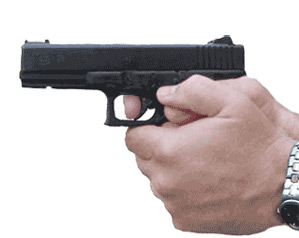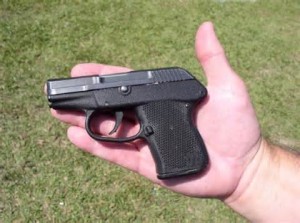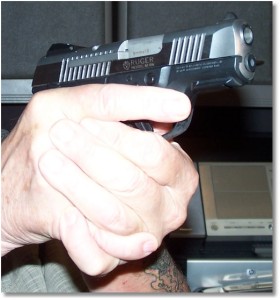My recent conversion to the Springfield XDs 45 for EDC presented two challenges to overcome for a person with somewhat large hands: a thin grip area and a short grip length. I did not want to resort to a grip sleeve nor Talon grips, as I really like the texture of the grip itself. I have to admit; however, that I do wear a shooting glove when I intend on putting several hundred rounds downrange during a training session. The grip of the XDs can imprint itself on the hands real quick even when shooting range ammunition. I had to adapt to the pistol in order to become proficient with it. My hands are not going to get smaller and the gun is not going to get bigger. The XDs, in .45 Automatic Colt Pistol, is a small pistol in a major caliber and control is everything.
The “working” magazine that I carry is the standard 5-round magazine for the Xds 45 and does not have a magazine extension. There is no “pinky rest”, so to speak. The two 5-round spare magazines do have magazine extensions but these are not for providing a rest for the little finger; rather, they provide a better “locating” point when removing them from magazine carriers for a reload than do the standard magazine bases. Although 7-rounds magazines for the XDs45 are available, I carry the 5-round magazines for several reasons that are beyond the scope of this article. Granted, a 7-round magazine, with magazine sleeve, does provide a longer grip length, but it is immaterial in things that matter to me. I do not grip the full length of a handgun grip and I do not grip with the little fingers of the hand.
Compact and sub-compact handguns are jumpy little things. Because of the short barrels of these guns, any tendency that the operator may have with flinching or not operating the trigger properly is exaggerated at the muzzle end – even at short distances. The grip on compact and sub-compact handguns must be as rock-steady as possible while allowing the flexibility of the trigger finger to do what it is supposed to do.
With the XDs45 (and some others), I adopted a grip that while unconventional, works for me. My Since I grip a handgun with only two fingers of the shooting hand (the middle and ring fingers) and three fingers of the support hand (index, middle, and ring fingers), the lack of use of the little finger(s) allowed me to experiment with my grip. This new gripping technique (new to me anyway), provides the maximum amount of grip against the gun, but does take some preparation and training to develop the muscle memory so as the grip becomes second nature. While I have not mastered the technique yet, I am very close to doing so at moderate speeds.For pistols or revolvers, when starting at the high ready position, thrust the little finger of the shooting hand straight out toward the muzzle. The support hand then encompasses the fingers of the shooting hand with one difference; place the little finger of the shooting hand between the little finger and ring finger of the support hand. The thumb of the support hand points to the muzzle while the thumb of the shooting hand is rested on the thumb of the support hand when there is no external safety, as with the XDs45. When the pistol has an external safety, such as with the Bersa Thunder 45UC (and others), the thumb can rest on top of (when down is off safe) the thumb safety – or – on top of the thumb of the support hand (when up is off safe) as dictated by the position of the thumb safety when in fire mode. Regardless of the safety position, the “straight thumbs” technique (Brian Enos, along with his good friend Rob Leatham, developed the straight-thumbs method of gripping a handgun that is today’s standard) is retained with the gripping method that I use. With pistols, as with revolvers, as I want as much of my hands and fingers around the grip of the gun as possible.
With revolvers, of course, the whereabouts of the index finger of the support hand is important. Due to side flash, it is widely advised to keep the index finger behind the front of the revolving chamber. There are those who like to place the index finger on the front of the trigger guard and there are semi-automatic pistols that provide a means to do so. If you transition from a pistol to a revolver, placing the index finger of the support hand on the front of the trigger guard is not a good thing and can be detrimental to your future gripping of a handgun.
Although it works well with revolvers, placing the thumb of the support hand over the thumb of the shooting hand is also not advisable when you transition from a revolver to a pistol. A recent incident at a local range reinforced this advisement. A woman, new to shooting, decided to do this technique with her newly purchased .380 pistol. There was much blood, wailing of hands, and gnashing of teeth. This event occurred shortly after her “instructor” showed her the “Gansta Grip” method of shooting the firearm sideways. Luckily, the firearm was a small caliber and did not remove the thumb from her hand nor was much damage suffered when the pistol hit the floor. As for the woman, I am sure that she will remember the trauma well. As for her “instructor”, I cannot force myself pen the words to express what I think. I digress, however.
Using the interlocked small fingers, along with the standard “thumbs forward” gripping technique when operating a compact or sub-compact pistol, provides me with more hand surface area with which to achieve a rock solid grip. I have also noticed better recoil control with the small pistols that I carry; I can achieve a stronger grip where need it. The technique felt strange at first, but with practice is starting to feel more natural to me. I have practiced the grip technique from the high ready position; it is just one more step to integrate it into my draw, since my draw comes from the holster, to the high-ready position and then out to the target.
I expect criticism about this change to my gripping a handgun. I can only say that this works for my hands and my small handguns. I have tried the technique with medium to large semi-autos and revolvers and I feel confident using it with them as well.
See also:
The Combat Grip @ http://www.handgunsmag.com/2010/09/24/tactics_training_combatg_100306/
The Correct Handgun Grip For Pistols And Revolvers @ http://www.christiangunowner.com/correct_handgun_grip.html
FUNDAMENTALS OF SHOOTING GRIP @ http://www.friedmanhandguntraining.com/grip.html
![]()




